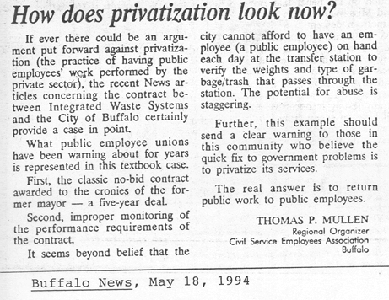The letter at left followed a series of articles in the Buffalo News detailing alleged over-charging by Integrated Waste Systems, Inc. (IWS), under its waste hauling contract with the City of Buffalo, summarized below. IWS wants to put a 915,000 ton-per-year landfill in Farmersville, NY.
According to the Buffalo News, under a contract with the outgoing Masiello administration Integrated Waste Systems (IWS) was permitted to charge the City of Buffalo $13 a ton to haul "garbage" but $35 a ton to haul "trash," defined as bulky items like mattresses and carpets. Also under the contract IWS was allowed to charge the higher rate for an entire load if five percent was "trash." If IWS employees couldn't see what was in the load, they were reportedly ordered to call it "trash." During the first week of May, 1994, a reporter for The Buffalo News rode with a city driver taking bulky trash to the city's transfer station, operated by IWS. Of 239 loads of trash brought to the transfer station, the IWS employees who checked the load logged only six as trash. Even after labeling a truck's receipt as "garbage" the IWS employee told the truck driver to dump his load in a bay designated for "trash." (Buffalo News, 5/8/94)
If that wasn't bad enough, IWS was also caught mixing Buffalo city waste with waste hauled from other muncipalities, allowing IWS to be paid twice for parts of the same truckload. (Buffalo News, 5/15/94)
Buffalo City Common Council member Eugene Fahey told IWS chairman Harry Williams, regardless of the terms of the contract, "I think you're robbing the City of Buffalo, and I think you're commingling garbage with other municipalities." Fahey also accused Williams of circumventing the bid process for the contract. (Buffalo News, 5/16/94)
The Council went on to consider a resolution to rescind the contract with IWS. By November the pressure was too much, and IWS sold all its hauling contracts, the most lucrative part its business, to CID of Sardinia. (Buffalo News, 11/8/94)
Since 1992 Denmark has required all solid waste landfills be publicly owned due to postclosure contamination concerns. Katherine N. Probst and Tonmas C. Ceierle, The Evolution of Hazardous Waste Programs: Lessons from Eight Counties (1999), p. 62.


